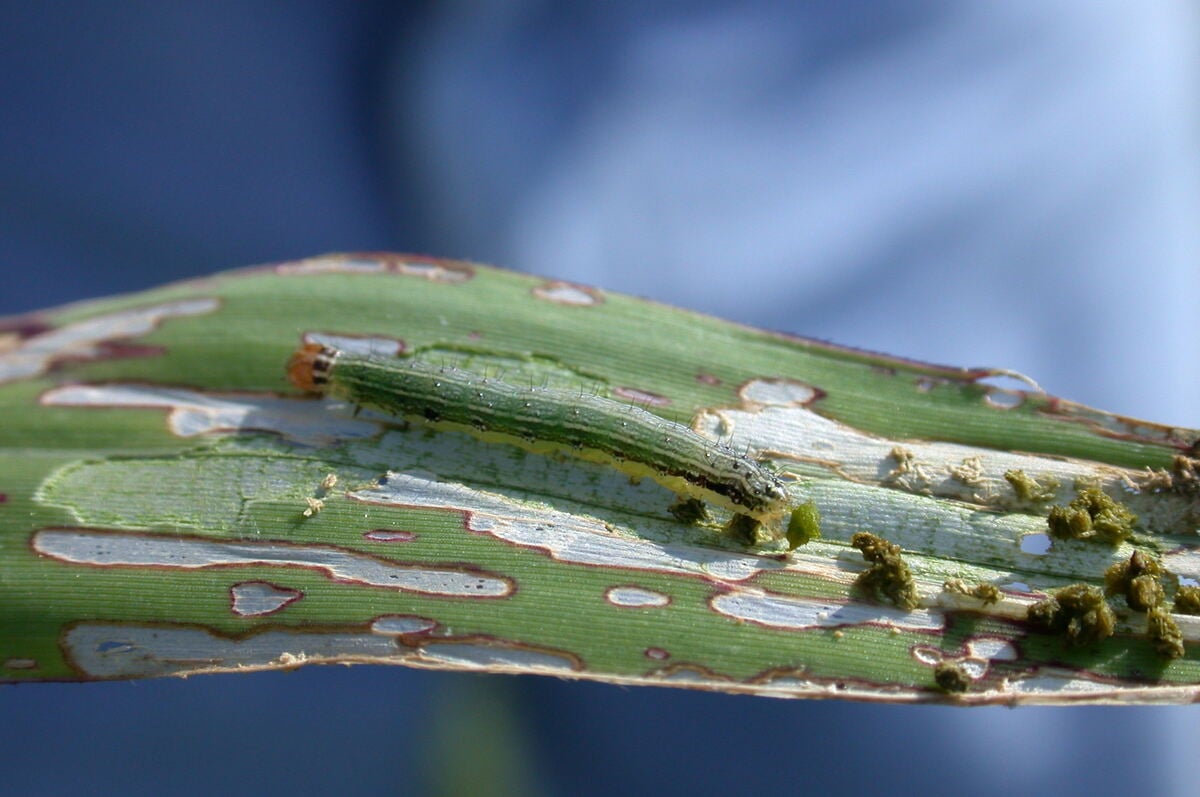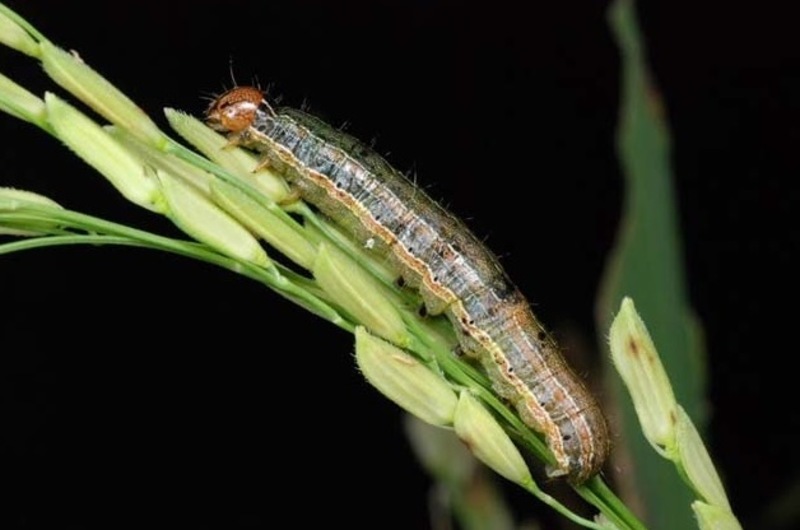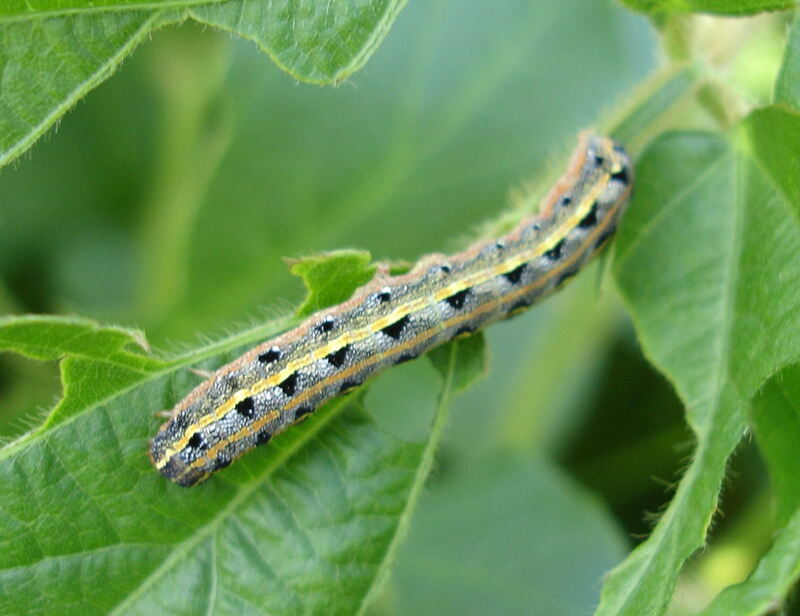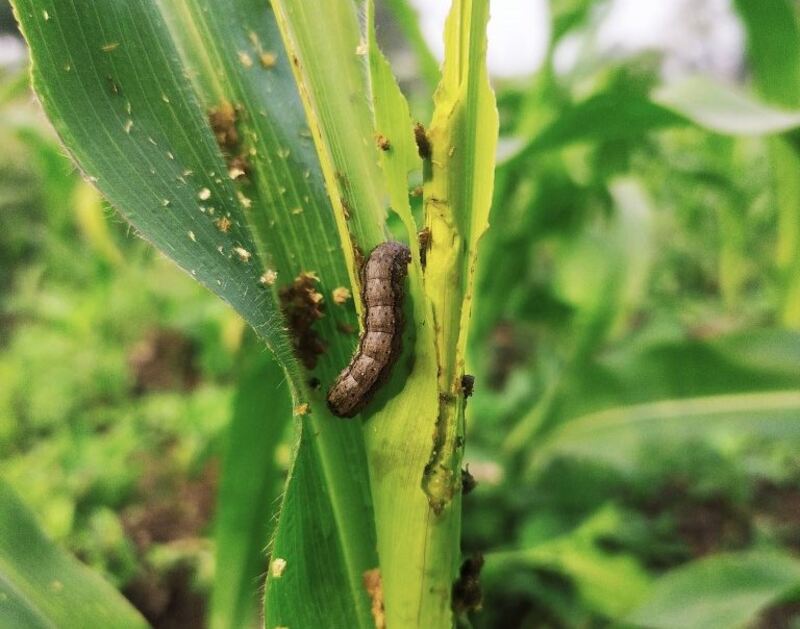
Caterpillars and brown spots appearing on your lawn can mean only one thing: an armyworm invasion. Experts say Bt, beneficial nematodes, and pyrethroids are among the best methods to get rid of armyworms in your lawn.
The fall armyworm outbreak in 2021 caused major damage to farmers and homeowners. In the fall of 2024, Ohio State University released a new armyworm alert, along with universities from Maryland down to Georgia. Learn which control methods to use to stop an armyworm invasion in your yard.
How to Get Rid of Armyworms Naturally

Natural remedies are the best solution for getting rid of armyworms on the lawn, especially if you have kids or pets.
| Type of Treatment | Effectiveness | How Long it Takes/Best For |
| Hand Pick | High | A few minutes or a few hours, depending on the size of the armyworm infestation. Best for small infestations. |
| Natural Enemies | Medium | Natural predators should be around all year. Best for preventive maintenance. |
| Beneficial Nematodes | Medium | Several days. Best for small infestations. |
| Bacillus Thuringiensis (Bt) | High | 2 to 3 days. Works best on young larvae. |
| Azadirachtin (Neem Oil) | Very high | A few days. Works best on young larvae. |
Hand Pick
When to use: All larval stages. Most helpful for large larvae, easy to see and grab. Works best on small infestations.
Pick the armyworms one by one from the grass canopy. Prepare a bucket with a gallon of water mixed with a teaspoon of dish soap, and throw them into the bucket. The soap will kill them within minutes.
Pro Tip: If you’d rather not get rid of an insect army yourself, find a lawn treatment pro in your area.
Natural Enemies
When to use: Support their presence year-round as a preventive measure.
Ladybugs, lacewings, and minute pirate bugs feed on armyworm eggs and young larvae. Birds also prey on armyworms. Trichogramma wasps are parasitic wasps that lay their eggs inside fall armyworm larvae, killing them from within.
To attract and support these beneficial insects: Add flowering plants that provide pollen and nectar around your lawn. Avoid spreading synthetic insecticides.
If you buy and release: Place the container with the insects in areas with a large population of armyworms. Release the insects in the early evening. Mist the surrounding vegetation with water.
Beneficial Nematodes
When to use: Most effective on small infestations.
Beneficial nematodes are microscopic worms that eat armyworms from the inside out, leaving only their empty shells.
Here are the common species that target armyworms:
- Heterorhabditis bacteriophora
- Steinernema carpocapsae
For nematodes to be effective, you must handle them properly from the provider to the application.
Beneficial nematodes “need to be obtained from a reliable source for good product quality, as they are living organisms that can be killed by heat, desiccation, and UV radiation,“ says Dr. Shaohui Wu, assistant professor of turfgrass health at the Ohio State University.
Apply early morning, late afternoon, or on an overcast day (nematodes are sensitive to sunlight). Reapply according to the package directions.
Pro Tip: Do not use beneficial nematodes combined with beneficial insects, since beneficial nematodes also prey on those insects.
Bacillus Thuringiensis (Bt)
When to use: Most effective on young larvae. Apply within a week after spotting egg masses.
To work as a biological insecticide, Bt must be eaten by the insect. Inside the insect, Bt toxins bind to the gut wall and cause its cells to break apart. Within minutes of eating Bt, the insect stops feeding.
Bt can kill the armyworm in its larval (immature) stage within 48 hours of ingestion. The specific strains that target armyworms are Bt aizawai and Bt kurstaki.
Pro Tip: Direct sunlight inactivates Bt, so spread the solution in the late afternoon.
Bacillus thuringiensis bacteria can also be used to control cutworms, sod webworms, beetles, and the larvae of mosquitoes.
Azadirachtin Insecticides (Neem Oil)
When to use: Most effective on young larvae. Apply within a week after spotting egg masses.
Azadirachtin is an organic substance found in the seeds of the neem tree. This natural pest control product is primarily an antifeedant, but it also disrupts normal insect growth, repels larvae and adults, sterilizes adults, and deters egg laying. You can find it as an active ingredient in organic insecticides.
Wu specifies that neem oil needs to contain azadirachtin to be effective (not all products in stores do). Look for 100% or 70% neem oil labeled as an insecticide or fungicide. Neem oil can be used as a spray to apply on your yard.
How to Get Rid of Armyworms with Chemicals

Using organic, natural insecticides is ideal. However, overwhelming armyworm infestations in late summer or fall might require chemical insecticides.
| Chemical | Effectiveness | How Long it Takes/Best For |
| Pyrethroids | Very high | Kills on contact. Works best on young larvae. Its residue lasts for days or even a few weeks. |
| Spinosad | High | 1 to 2 days. Best when larvae are small. |
| Carbaryl | Very High | Less than 1 hour after contact or ingestion. Use on large infestations. |
| Chlorantraniliprole | High | Kills armyworms in a few days. Works on any size of armyworm and as a preventive. |
Pyrethroids
When to use: Most effective on younger larvae.
Some of the best insecticides for armyworms are pyrethroid-based products. Pyrethroid insecticides kill larvae quickly upon contact, and the residue lasts for days or even a few weeks. Look for products with these ingredients:
- Permethrin
- Deltamethrin
- Bifenthrin
There’s a catch, though: Some pyrethroid insecticides require a license. You might need a lawn treatment pro’s help to take care of this application.
Note: Pyrethroid insecticides can also kill beneficial insects like ladybugs and bees.
Spinosad
When to use: Best to use when larvae are small.
Spinosad is a natural bacterial toxin that is very effective against armyworms. When armyworms ingest or come in contact with spinosad, it immediately causes them to stop eating and kills them in 1-2 days.
There are two forms of spinosad:
- Soil bacterium, an organic option.
- Bacteria with added petroleum derivatives, an inorganic (chemical) option.
Note: Spinosad is extremely toxic to bees, especially when wet.
Carbaryl
When to use: When there is a large infestation of armyworms in your lawn.
Carbaryl is a general-use insecticide that has long been used against armyworms in home lawns and agriculture. When the armyworms ingest or come in contact with carbaryl, it works as a stomach poison or nervous system disruptor to kill them. They’ll stop eating within the hour and die soon after.
Note: Carbaryl can be toxic to humans and might kill beneficial insects.
Chlorantraniliprole
When to use: Effective against armyworms of all sizes. Also works as a preventive.
Chlorantraniliprole is a systemic insecticide classified in the toxicity category IV: non-toxic and not an irritant. Once ingested, it takes only hours for armyworms to stop eating and kills them within days. Armyworm control lasts for several weeks. It can also be used to control grubs and Japanese beetles.
“Once caterpillars increase in size, chlorantraniliprole insecticide might be the best option,” says Dr. Shimat Joseph, associate professor of turfgrass and ornamentals at the University of Georgia.
Note: Chlorantraniliprole will harm moths and butterflies and may be toxic to bees.
Be Victorious in the Battle Against Armyworms

Whether you choose to combat armyworms with natural remedies or chemical pesticides, you can win the fight against this destructive lawn pest. If armyworms have taken over your yard, don’t wait to find a lawn treatment company near you.
Read More:
- What Are Armyworms?
- How to Prevent an Armyworm Infestation
- Signs of Armyworm Damage
- How to Get Rid of Armyworms in the Garden
Sources:
- “Armyworms in Sod.” By Shimat V. Joseph, associate professor, William G. Hudson, professor and Extension entomologist, and Clint Waltz, Extension specialist. University of Georgia Extension.
- “Bacillus thuringiensis (B.t.).” By Ron Kujawski. University of Massachusetts Amherst.
- “Cutworms and Armyworms.” University of California.
- “Neem: A Tree For Solving Global Problems. 5. Effects on Insects.” By National Research Council (U.S.) Panel on Neem. National Library of Medicine.
- “Fall Armyworm Alert!” By Dave Shetlar, entomologist, and Shaohui Wu, entomologist. The Ohio State University.
- “Fall Armyworm Alert.” By David Buntin, entomologist, Will Hudson, entomologist, and Lisa Baxter, agronomist. University of Georgia Cooperative Extension.
- “Fall Armyworm Alert: Scout Sod and Pastures!” By Kelly Hamby, entomologist, and David Owens, entomologist. University of Maryland Extension.
- “Fall Armyworm Control in Home Lawns.” Iowa State University Extension and Outreach.
- “Fall Armyworm: Biology and Management in Georgia Turfgrass.” By Shimat V. Joseph, entomology expert. University of Georgia.
- “Look Out for Fall Armyworm! Organic Options.” University of Georgia Extension.
- “Parasitoid Wasps.” By Mike Raupp, professor, Jon Traunfeld, Extension specialist, Chris Sargent, faculty specialist, and Madeline Potter, Extension agent associate. University of Maryland Extension.
- “Pesticides: Carbaryl/Sevin.” Missouri Botanical Garden.
- “Pesticide Fact Sheet.” Environmental Protection Agency.
- Shaohui Wu, assistant professor of turfgrass health at the Ohio State University, Columbus, OH. The Ohio State University. Personal interview.
- Shimat V. Joseph, associate professor at the University of Georgia, Griffin, GA. Personal interview.
Main Image Credit: Armyworm on a leaf. uacescomm / Flickr / CC0 1.0